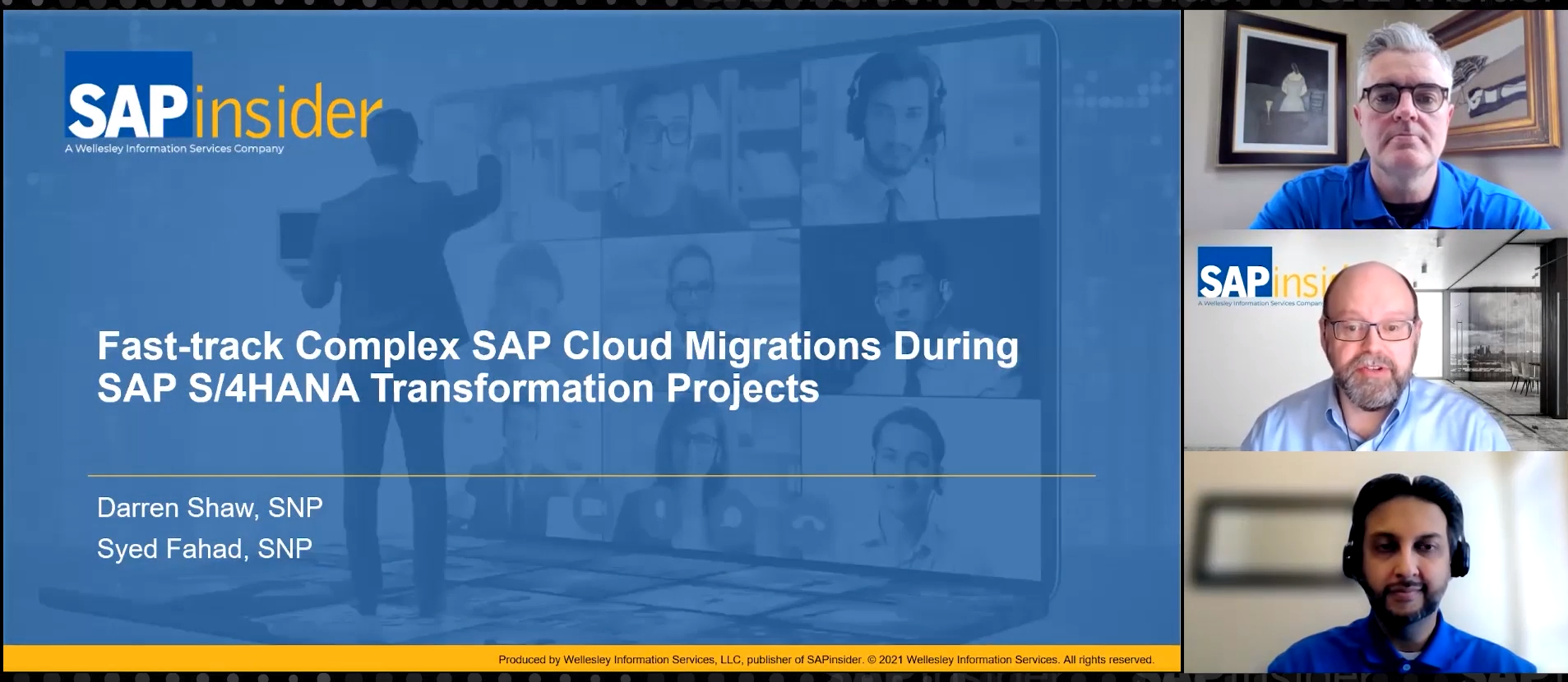Simplify System Refresh and Reclaim 80% of your Cost and Time Investment
Key Takeaways
⇨ Increasing demand for up-to-date test data calls for frequent system refresh which means more complexity, downtime, errors, and effort consumption.
⇨ Companies are turning towards automation for efficient, error-free, faster system refresh with better resource optimization.
⇨ Symphony, an AI driven IT Automation tool from BCS, allows you to simplify the end-to-end system refresh operation.
Sample this: A study by IBM Big Data and Analytics Hub website cites that “For every USD 14 million delivery by the software development and QA team, a hidden USD 3 million was being spent on data management. All data management tasks included moving data from back-end systems to identifying test data, data masking of sensitive data, skipped production defects due to unavailability of correct test data, manipulation of data for different scenarios, and storage of test data.
Infrequent and inaccurate system refreshes are major factors contributing towards the unavailability of up to date and correct test data.
However, conventional manual system refresh approaches are inefficient, complex, tedious, and error-prone having a huge impact on the business owing to a substantial downtime.
Explore related questions
In such cases, automation does seem to be a viable option. But what factors deter organizations from adopting these automation solutions?
- Hefty investment
- Lack of integration across heterogenous IT environment with diverse systems, databases, and applications.
- Inability to achieve near zero downtime.
- Absence of flexibility to accommodate the variations in system architecture.
- Lack of end-to-end automation
Top 6 Challenges in SAP system Refresh:
Complexity: System refresh at the outlook seems like a simple process of copying and refreshing the data from a production environment to a non-production environment, such as a quality assurance (QA) or development system, however it is time – consuming and complex process with number of steps spanning over several phases such as pre-refresh, backup and restore, post-refresh, validation and release.
System refresh for tightly integrated ones like SAP ERP and CRM, requires careful planning and coordination.
Time: Crunched timelines and system refresh go hand in hand. A typical refresh of an SAP System consumes 5 to 9 working days of consultants from different teams such as DB, Basis and Cloud. To add to the woes, the requests for system refresh are predominantly ad hoc requiring the team to hit the ground running.
Dependencies: System refresh activities encompass a range of tasks managed by different teams, such as DB and cloud operations. Coordinating activities among teams and ensuring alignment becomes crucial for successful execution. If team members do not properly hand over their responsibilities before leaving the organization for various reasons, it can be challenging to pick up where they left off.
Error prone: System Refresh involves detailed runbook, with each refresh requiring completion of 70-80 tasks. The complexity increases exponentially when multiple systems are refreshed simultaneously. Errors are almost inevitable in such intricate processes. For instance, an incorrectly triggered email or a wrong purchase order (PO) can have a significant impact on business operations.
Downtime availability: System refresh typically takes 5 to 7 days, during which the quality system is unavailable. This extended downtime significantly impacts the project team’s ability to perform testing, leading to delays and disruptions. It’s important to note that this process typically impacts on the QA system, with potential repercussions on project deliverables and brand reputation. Error in the system refresh process can lead to unplanned downtime, significantly affecting operations.
Research by the Ponemon Institute indicates that an average minute of unplanned outage costs approximately $9,000, equating to over $500,000 per hour. In certain industries like banking and manufacturing, this cost can soar to around $9 million per hour (Ref: Statista).
Business impact: The BDLS transaction, used for converting logical system names, often takes a considerable amount of time to complete. This extended duration can impact project timelines and requires proactive management to minimize delays.
Symphony approach to overcoming Refresh challenges.
Symphony is a one-stop solution for all the afore-said challenges.
Symphony, an AI driven IT automation platform provides a streamlined approach which automates the runbook of the whole system refresh process by leveraging standardized templates. Thereby it reduces documentation, minimizes coordination efforts, resource dependencies and downtime allowing you to perform refreshes of any number of systems in parallel.
Symphony’s Approach:
Symphony, BCS’s AI-driven IT automation tool, performs critical tasks like exporting system configurations, copying databases and importing configurations transforming days of work into hours that leads to seamless, error-free, and swift operation.
- In the pre-steps phase, the automation with Symphony automates the export of system configuration of the existing system as a table.
- In the perform System Copy step, Symphony automates the process copying the PRD system’s database into QA or DEV system.
- As a part of the import system configuration step, configuration data from the new system, stored in the file system, is imported into the new QA system.
- Why Choose Symphony?
- If you are looking for a solution that offers:
- Automation across the full stack
- End-to-End handling of the whole system refresh operation
- Near zero downtime during the refresh process
- Zero issues during and after the refresh
- Optimization of system refresh time and efforts
Then look no further.
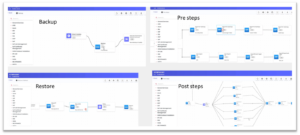

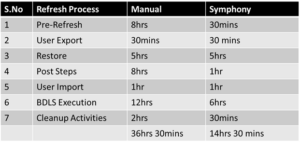
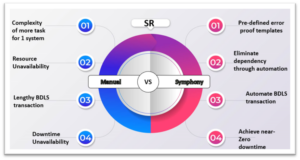
How does a Symphony achieve a Near Zero Downtime?
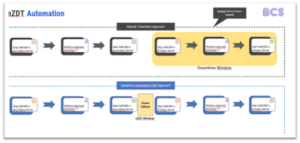
In hyperscale cloud environments like AWS, Azure, and GCP, system refreshes can be completed in 6 to 8 hours instead of 5 to 7 days. This is achieved through Symphony, which builds a temporary quality system where all activities are performed. Once complete, Symphony swaps the temporary system with the quality system, reducing the refresh time from days to hours. Symphony enables concurrent completion of pre-refresh and post-refresh tasks, effectively reducing the overall runtime of the refresh process. This approach minimizes system unavailability time, leading to near-zero downtime. Operations continue without a hitch, maximizing resource utilization and enhancing overall efficiency.
Feats of Symphony
Some of the feats of Symphony in the past 6 months:

A multinational company with global operations conducts System Refresh that involves installation, database cloning and network configuration. With 22-23 complex SAP landscapes, manual refresh would take 2 weeks with 10 resources. However, with Symphony, the entire operation for 40 systems were completed with only 3 resources with up to 80% savings of time and costs.
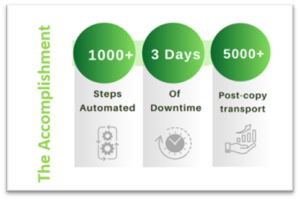
RaaS- (Refresh as a Service):
Symphony is a comprehensive and all-encompassing tool for automating your IT operations. But if you are looking for a tailor-made solution to only handle your System Refresh operations, we have you covered.
Refresh as a Service (RaaS) is a managed refresh service from BCS THAT allows SAP clients to either purchase a package with a specialized number of refresh or order client refresh or builds as needed. Refresh as a Service refresh spans a number of modules, including SAP HCM, ERP, CRM, SRM, SCM, and GTS.
Benefits of RaaS:
- Customization options
- Hassle-free system refresh operations throughout the year
- Freeing up in-house consultants’ time and efforts
- Quick implementation

Ready to streamline your SAP system refresh process and achieve near-zero downtime? Learn how our solutions can help you overcome complexity, reduce time constraints, and minimize risks. Contact us today to schedule a consultation and take the first step towards smoother system refresh!
Click here to schedule a demonstration/ meeting with us.



